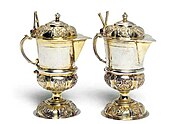Measuring jug
Measuring jugs , also known in church Latin as urceolus or amula and in art history as measuring pollen , are sacred devices for wine and water in the holy mass of the Catholic and Anglican churches. The measuring jugs were mentioned for the first time in the Statuta ecclesiae antiqua from the 5th century; they were only used regularly from the 12th century.
At the celebration of the Eucharist , two pots filled with mass wine and water are brought out, made of precious metals, e.g. B. silver, copper, brass or tin or made of glass, nowadays sometimes made of ceramic. During the preparation of the offering, wine and a little water are poured into the chalice and thus mix. The wine stands as a symbol for the divine nature of Jesus Christ , the water for his human nature.
The ornamental and formal shape of the jug depends on the prevailing art style of the different times. Artistically designed pots have been preserved from the Romanesque period. While in Italy the pots are provided with a thin pouring tube, in France they are in the form of bottles or small jugs. They stand on a tray, which is also in the hand washing of the priest celebrant collects the water. If they are made of opaque material, they can be marked with V (for Latin Vinum 'wine') and A (for aqua 'water'). A goblet spoon, with which the celebrant can pour a little water from the jug into the goblet, is often part of the goblet set.
In the festive service, the wine can be brought in the offertory procession, the bishop or priest in a decorated pot and the water jug on the sideboard are provided. You can also wash your hands with your own jug and basin.
literature
- Rupert Berger : The liturgical devices In: Rupert Berger u. a. (Ed.): Church service. Handbook of liturgical science. Part 3: Form of worship. Linguistic and non-linguistic forms of expression. Verlag Friedrich Pustet, Regensburg 1987, pp. 289–307, here p. 306
